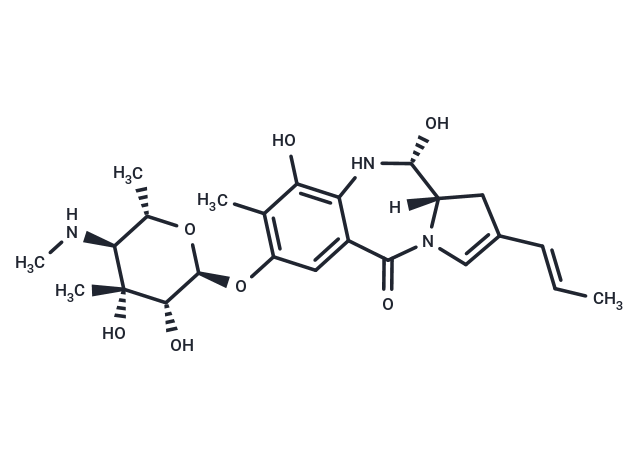Shopping Cart
- Remove All
 Your shopping cart is currently empty
Your shopping cart is currently empty

Sibiromycin, a glycosylated pyrrolobenzodiazepines (PBDs) compound, is a naturally occurring and potent antitumor antibiotic. It exerts its activity by covalently binding to DNA in the minor groove at the NH2 of guanine.

| Pack Size | Price | Availability | Quantity |
|---|---|---|---|
| 5 mg | $1,859 | Backorder |
| Description | Sibiromycin, a glycosylated pyrrolobenzodiazepines (PBDs) compound, is a naturally occurring and potent antitumor antibiotic. It exerts its activity by covalently binding to DNA in the minor groove at the NH2 of guanine. |
| In vitro | Pyrrolobenzodiazepines (PBDs) are highly specific DNA alkylating agents known for their exceptional antineoplastic properties, effectively targeting and binding to DNA sequences with a preference order of 5′-Pu-G-Pu>5′-Py-G-Pu>5′-Pu-G-Py>5′-Py-G-Py. Among them, anthramycin, sibiromycin, and tomaymycin demonstrate this sequence-specific action. Notably, sibiromycin exhibits potent cytotoxic capabilities against various cell lines, including L1210 (leukemia), ADJ/PC6 (plasmacytoma), and CH1 (ovarian), with half-maximal inhibitory concentrations (IC50s) ranging from 0.000017 to 0.0029 μM, highlighting its potential as a therapeutic agent. |
| Molecular Weight | 475.542 |
| Formula | C24H33N3O7 |
| Cas No. | 12684-33-2 |
| Storage | Powder: -20°C for 3 years | In solvent: -80°C for 1 year | Shipping with blue ice. |

Copyright © 2015-2025 TargetMol Chemicals Inc. All Rights Reserved.